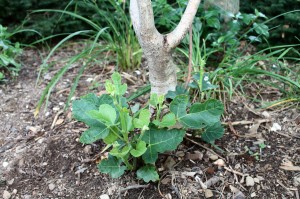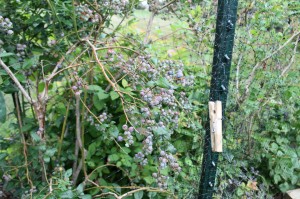Recovery and Bugs in the Eye
July 22nd, 2014
I keep hearing about apparently dead plants that are still, somehow, coming back to life.
Usually, end of May or maybe early June is the drop-dead date around here. If things aren’t leafing out or pushing up by then, you can figure it’s a winter casualty.
But this year, bared-out crape myrtles and hydrangeas were budding out for the first time the second and third week of June.
My ‘Brown Turkey’ fig that I gave up for dead started sending up shoots in early July, a week after I dug it, replaced it with a new ‘Chicago Hardy,’ and set it aside in a pot. Good thing I kept it, “just in case.” It’s back in the ground in a new spot and still growing.
Just a week ago, a reader from the East Shore said he was about to cut down some leafless hollies when he noticed new shoots poking up from around the base.
And then over the weekend, my friend and fellow gardener Cindy Rudisill from up in Lykens told me that her apparent cadaver passion vine finally decided to send up a shoot – in mid-July.
When will miracles cease?
I still haven’t dug out my lifeless ‘Adonis’ butterfly bush and barren ‘Goshiki’ osmanthus, so maybe they ceased there.
The death rate from this past winter is higher than I’ve seen in the last 20 years, but what’s recovered has been pretty amazing. Some of these late-comeback plants will take years to grow back to size and form (if ever), but at least it’s better than digging out and buying new.
Since the vortexish winter and cool start to the growing season, things have been chugging along rather nicely.
We’ve had some good warmth but few bouts of the sauna weather that we often get by July. Much of last week was actually very May-like pleasant.
We’ve had enough rain to keep the lawns green and most plants reasonably well hydrated.
The worst thing I can say (and gardeners always have to have something to complain about) is that the blackflies have been horrible this year.

Don’t know if you can see them or not, but blackflies are landing on and hovering around this fist in the air.
I haven’t seen them this bad in more than 20 years. I know someone who sprays for them, and he tells me I’m not imagining things. The state cut the blackfly-spraying budget, and that’s meant later and less spraying for these tiny bugs that are a gigantic nuisance.
Lots and lots of people apparently have been registering complaints.
Blackflies swarm around eyes and ears and noses, occasionally going into and up all of the aforementioned. They bite, too.
Decades ago, before the state started spraying waterways with Bacillus thuringiensis to control them, people would burn punk sticks, wear netted hats, and spray all sorts of repellents on themselves just to be able to go outside in peace.
I’ve had some luck by smearing Vicks VapoRub® on my hat, ears and nose. But they’re still bad.
I hope money gets restored to get these bugs back under control because in my opinion, that’s been one of the best investments of our state tax dollars.
Five other observations so far this season from George’s garden:
- Bird netting is useless against birds. When I don’t cover my five blueberry bushes to keep the birds off, I don’t get a single ripe berry. I secured my whole planting with two packs of bird plastic netting in June, but the birds merely pecked holes in it and flew right in.
- I haven’t seen any groundhogs in my yard. Yet. A groundhogless year would be a bigger miracle than a passion vine coming back to life in July.
- It’s been sneaky dry. It looks like we’ve been getting decent rain, but it’s either been less than it looks or so much all at once that most of it ran off. Dig down a little, and see if your soil isn’t almost dust under there, too.
- Tomatoes are coming along slowly. Several readers also have asked me about that, wondering if something’s wrong or if their tomatoes are ever going to ripen this season. The cool start slowed tomato progress, but we’ll have red tomatoes soon. I’m getting my first few early ones and cherry types.
- I haven’t seen many Japanese beetles. And I’m not hearing much about them from readers either. Here’s hoping they’re not just slow, too, or about to make a miraculously late appearance.









